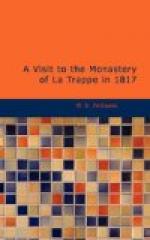The best method of travelling in this country is on horseback: in fact, it is impossible to proceed in any other way, after quitting the main road. Having procured a guide and horses, I set out early in the morning, crossing the Loire by the Pont Rosseau, to Verton, keeping along the banks of the River Sevres. Verton is a romantic village standing on a hill: most of the houses are in ruins, from the effect of the destructive war of La Vendee. From thence to Le Palet, most intricate narrow roads, or more properly speaking, pathways, darkened by the overhanging branches of trees, and in many parts deep with mire, from the sun’s rays not being able to dry the ground, make it difficult to proceed, and we several times lost our way. It was late before we reached Le Palet, and though I had not tasted food for many hours, I could not resist stopping to view so interesting a spot, and making a hasty sketch of the ruins of the house in which Abelard was born, and in which Heloise resided with him before their final separation. The ruins of the House of Berenger, the father of Abelard, are close to the church of Palet, on the left of the high road, three miles distant from Clisson. Le Palet is thus described by a French author, in the history of the Province.
“Cet homme si celebre par son savoir, ses amours, et ses infortunes, amena Heloise au Palet lorsqu’il l’eut enlevee de chez le Chanoine Fulbert, pour la soustraire au ressentiment de cet oncle jaloux et barbare; mais, oblige de quitter cette retraite paisible pour retourner a Paris, ou l’appelaient ses nombreux disciples, le soin de sa gloire et de sa fortune, Abelard confia a sa soeur sa chere Heloise et le gage precieux qu’elle portait dans son sein. Elle accoucha au Palet d’un fils d’une si rare beaute, qu’elle le nomma Astralabe, c’est-a-dire, astre brillant; mais l’absence de celui qu’elle adorait rendait moins vifs pour elle les doux plaisirs de la maternite; son ame expansive et brulante etait livree sans cesse a une inquiete et sombre melancholie qu’elle ne parvenait sans doute a dissiper qu’en venant sur les bords de la Sevres rever a l’objet de sa tendresse, et soupirer apres son retour. Sept siecles se sont ecoules depuis cette epoque, et les noms d’Abelard et d’Heloise embellissent toujours ce delicieux ravage. On interroge avec une curiosite avide ces roches eternelles et ces grottes mysterieuses qui furent les temoins discrets de leurs peines et de leurs plaisirs. On se reporte a ces temps recules ou ces amants venaient dans cette solitude enchanteresse, se confier mutuellement leur vifs inquietudes; on croit les voir s’egarer sous ces riants ombrages, et s’abandonner a toutes les inspirations de l’eloquence, a toutes les illusions de l’amour”.




